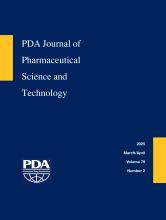Abstract
Pharmaceutical products are packaged in containers so that they can be manufactured, distributed and used. Because extractables from such containers are precursors of leachable impurities in the product, extractables represent potential hazards to user safety. Polypropylene resins are frequently used as materials of construction for packaging of liquid parenteral drug products. Thus extractables profiling of polypropylene resins may be an effective means of hazard identification associated with the resin's safe use. Twenty-one PP resins were extracted using aqueous and organic extraction solvents and the resulting extracts were screened for extractables using appropriate general chemistry, chromatographic and spectroscopic methodologies. The resulting extractables profiles were toxicologically reviewed by a defined process to identify potential hazards given a specified therapeutic application involving chronic use of a large volume aqueous parenteral drug product (LVP). The organic extractables profiles of individual PP resins were variable in terms of the individual extractable identified and their extracted levels, consistent with high variability in PP resin formulations and PP manufacturing. However, the profiles were similar in terms of the groups of extractable measured. Thus, for example, all the resins had extractables associated with antioxidants as all the resins contained antioxidants but the specific extractables for a given resin depended on the specific antioxidants present in that resin. Few of the targeted extractable elements were present in the extracts at measurable levels although most resins had measurable levels of extracted aluminum, silicon and alkali and alkaline earths. A worst case extractables profile (all the extractables measured in individual resins at their highest levels) was toxicologically reviewed considering an aqueous large volume parenteral (LVP) drug product. This review established certain extractables as potential hazards whose actual toxicological safety risk assessment would require more rigorous data and a more rigorous process than those used for hazard identification.
- Received November 9, 2016.
- Accepted April 26, 2017.
- Copyright © 2017, Parenteral Drug Association
PDA members receive access to all articles published in the current year and previous volume year. Institutional subscribers received access to all content. Log in below to receive access to this article if you are either of these.
If you are neither or you are a PDA member trying to access an article outside of your membership license, then you must purchase access to this article (below). If you do not have a username or password for JPST, you will be required to create an account prior to purchasing.
Full issue PDFs are for PDA members only.
Note to pda.org users
The PDA and PDA bookstore websites (www.pda.org and www.pda.org/bookstore) are separate websites from the PDA JPST website. When you first join PDA, your initial UserID and Password are sent to HighWirePress to create your PDA JPST account. Subsequent UserrID and Password changes required at the PDA websites will not pass on to PDA JPST and vice versa. If you forget your PDA JPST UserID and/or Password, you can request help to retrieve UserID and reset Password below.






